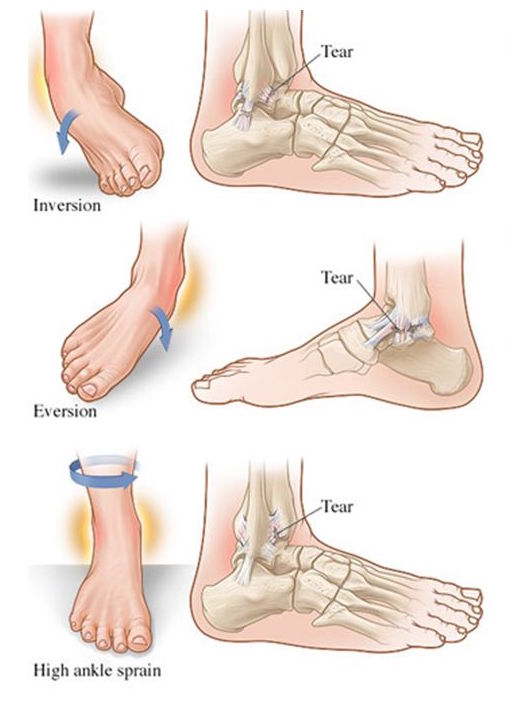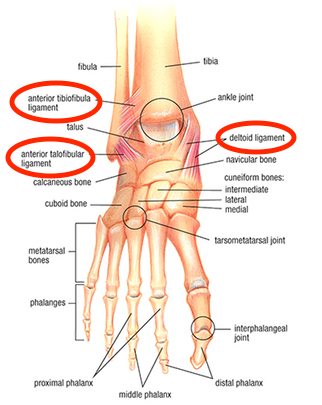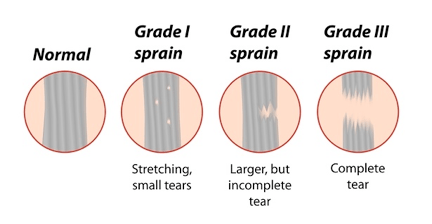Sprained Ankle? Learn How Bad it is and What To Do for it
Ankle sprains are one of the most common injuries in sports, particularly sports that involve cutting and pivoting, such as soccer, basketball, and football. Understanding what an ankle sprain is, how bad it is, and what to do for it will be incredibly helpful in minimizing time on the sidelines as a result of a sprained ankle.
A “sprain” occurs when a ligament, the tissue which connects bone to bone, is stretched or stressed beyond its capacity, resulting in the tearing of fibers. Sprains occur at the lateral (outside) ankle, medial (inside) ankle, or between the tibia and fibula (known as a high ankle sprain).

Lateral Sprain
A lateral ankle sprain is the most common type of ankle sprain and often involves the Anterior Talofibular Ligament (ATFL). This results from excessive inversion and plantarflexion (pointing toes down and turning inward). For example, this can happen if your ankle “rolls” when landing on another player’s foot or by stepping into a divot while running. The pain, tenderness, or bruising is primarily on the outside of the ankle.
Medial Sprain
If the injury occurs to the medial side of the ankle, the sprain likely affects the Deltoid Ligament and occurs when the ankle is forced into excessive eversion (rotating foot outward). For example, when two soccer players approach a ball, each connecting and driving the ball toward each other, the player with more force drives the ball through, while the other player’s foot gives way. If the ankle is forced beyond its eversion range of motion, then the medial ankle ligaments can become injured. The Deltoid Ligament is relatively large, compared to the ATFL, but can still become injured with enough force.
High Ankle Sprain
A High Ankle sprain involves the ligaments that hold the tibia and fibula together, and often occurs from extreme dorsiflexion (toes upward) and/or rotation, such as a plant-and-twist action. These movements can force the lower tibia and fibula bones to pull apart slightly, stressing the structures that hold them together. Pain may be located deep in the ankle or lower leg. A high ankle sprain requires a longer healing time compared to the other types of sprains.
Sprains are classified by the severity of tissue damage. Scroll down to learn how sprains are graded by severity.

How Bad is it? Sprain Grades (Classification)
Sprains are classified by grades or degrees of severity, ranging from over-stretching with micro-tears to complete rupture of the ligament tissue. The healing time and treatment recommendations will vary based on the severity of the injury.

Grade I (mild) Ankle Sprain
Stretching of the ligament with some damage to fibers; Minimal swelling and tenderness; Minimal to no functional loss; No ligament laxity (joint is stable);
Typical healing is 2-10 days.
Recommendations: Weight-bear as tolerated. PRICEMEM (scroll down for more info). Restore flexibility, range of motion (ROM), and strength as tolerated. Physical Therapy may be necessary to return to sports without limitations and to reduce likelihood of re-injury.
Grade II (moderate) Ankle Sprain
Partial tear of ligament; Moderate swelling, pain, or tenderness; Mild to moderate ligament laxity (joint may be unstable); Minimal to moderate functional loss.
Typical healing time is 10-30 days.
Recommendations: Immobilization and limited weight-bearing might be necessary (i.e. brace/tape, CAM boot, or crutches). PRICEMEM. Physical Therapy to progress tissue loading for appropriate healing; reduce swelling and restore ROM; gradually improve strength, proprioception, and agility with neuromuscular training for a safe return to sports.
Grade III (severe) Ankle Sprain
Complete tear or rupture of ligament; Significant swelling, bruising, and tenderness; Positive for ligament laxity (joint instability). Moderate to severe functional loss with difficulty walking. In a severe sprain, the ligament may pull off a piece of the bone, resulting in an avulsion fracture.
Typical healing time is 6-12+ weeks.
Recommendations: Consult with a medical professional to rule out a fracture. Immobilization and restricted weight-bearing as advised. Surgery might be necessary. PRICEMEM. Physical Therapy similar to Grade II, with slower progression to respect longer healing time.
Management of an Acute Ankle Sprain
You have probably heard of RICE for managing an acute injury with swelling. The basic concepts of RICE are still practiced, but we now encourage more comprehensive guidelines for a more active recovery for athletes wanting to recover quickly from musculoskeletal injuries.
PRICEMEM stands for Protect, Rest, Ice, Compress, Elevate, Manual Therapy, Early Motion, Medication.
The goals in the initial stage of an acute injury or trauma are to decrease swelling, improve circulation, and restore mobility. The following strategies will help you to manage an injury during its acute phase to facilitate a better overall recovery and get back to sports or activities more quickly.
PROTECT: You must protect the injured tissue from overuse and reinjury during the healing process. For a weightbearing joint, it might require the use of crutches, a CAM boot, or a brace. For a shoulder injury, it might require the use of a sling. Pain is often a good indicator that a tissue is being stressed and should be protected.
REST: Injured tissue needs time to progress through the healing stages and may require a period of rest in order for swelling and inflammation to subside. “Rest” is relative and does not necessarily mean to avoid all activity, but to avoid stressing the healing tissue. Movement in safe ranges and with appropriate intensity is beneficial for overall healing and getting back to sports.
ICE: Ice reduces swelling of the affected area, minimizing secondary hypoxic injury to surrounding tissues. Ice for 15-20 minutes, 2-3 times per day in the acute phase of injury. A cold-pack like the one shown below is an excellent option as it conforms to the surface and maximizes surface area contact. Investing in a good cold-pack for an athlete is highly recommended.
COMPRESS: Compression using a wrap may reduce excessive swelling of the affected area.
ELEVATE: Elevating the area of injury above your heart can reduce accumulation of excess fluid.
MANUAL THERAPY: Manual therapy, typically performed by a Physical Therapist or licensed medical professional, can be helpful in reducing swelling and pain, while promoting circulation and mobility, speeding up the recovery process. Manual techniques can also help to decrease scar tissue development, improve soft tissue integrity, improve muscle activation, restore muscle balance, and normalize movement patterns / mechanics.
EARLY MOTION: Early motion will prevent stiffness, promote circulation, and improve pain-free mobility.
MEDICATION: Medication may be prescribed by a physician to control pain and inflammation in the acute or sub-acute phase of injury.



